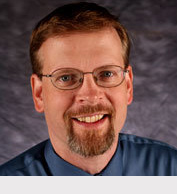FAITH + IDEAS =: last updated 05/09/2011
May 4, 2011 Volume 4 Issue 8
. . . an e-conversation with the Faculty of Gordon College . . .
By Michael Monroe
May of 1913 saw the premiere of Igor Stravinsky’s The Rite of Spring, a ballet notorious both for the raw, seemingly unrefined atmosphere it evokes and for the demands it makes on its musicians. The story concerns a primitive, pagan sacrifice and the music is wild and otherworldly, still fearsome to most ears after almost a century.
And yet, summoning this uncivilized world requires a highly civilized and disciplined orchestra of about 100 players, all prepared to negotiate complex rhythmic intersections and grueling instrumental demands. We can be pretty sure that ancient Russian music didn’t actually sound like this, but Stravinsky’s score has become the most iconic musical work of the 20th century, in part because it puts its listeners in a startling but thrilling place.
What amazes me is that after listening to this music for years, it still sounds unpredictable, even though I know what is coming. It’s as if Stravinsky encoded a permanent sort of unpredictability into his very specific notations. Of course, we find the same thing happening in the best suspense novels and horror films, which keep us on the edge of our seats even when we know what will happen. In fact, this is the kind of thing art is always doing: art is art-ificial after all (real pagan sacrifices aren’t usually accompanied by enormous orchestras). But when it works, we stop noticing the artifice and are freed to experience the artist’s vision again.
For musicians, the hours spent constrained by studying and practicing are what make us free to be expressive and unconstrained on stage. Training one’s muse sounds counterintuitive, but most artists know that the imposition of artificial constraints can free the creative spirit. Perhaps more than a million hours of combined playing experience are required to produce a successful performance of The Rite of Spring, but both performers and audiences find that the composer’s rigorous demands allow a paradoxical escape from the modern world.
For American college students and professors, the arrival of May signals the end of the school year and an escape from the rigors of academic life. Whereas March’s spring break is an intermission from upcoming papers or exams, May offers a real opportunity for the kind of renewal we associate with spring.
This is not to diminish the joy that intellectual pursuits can bring, but one of the most important tests of an education is to find out who we are once the exams are over. Hopefully, in addition to providing some career credentials and useful knowledge, education is a freeing experience.
Again, this might seem counterintuitive—when studying for a final exam or grading a large stack of papers, one hardly feels free. As with the musician trying to count his way through Stravinsky’s maze of mixed meters, fearing the conductor’s wrath at an ill-timed entrance, college life can be full of times when we feel oppressed by obligation or fear of failure. It can seem that the only freedom college offers is during the breaks.
The truth is that the real freedom is often experienced years later, when mastery has settled in. That’s why it’s important to believe in the process. Learning to read can be an imposing task in first grade, but it’s a skill that frees us in countless ways when it becomes second nature.
In the church calendar, May falls within the Easter season, and Easter is, of course, another rite of spring. Christians celebrate the freedom and new life that were won by an altogether different sacrifice; but this new life is still animated by the idea that some apparently constraining principles, such as loving one's neighbor, can actually free us to be who we’re intended to be.
True growth is hard to measure day by day or test by test. But May is a time to think back not just on a year, but on how a lifetime of learning frees us to know the world in new, thrilling, and even startling ways.
Dr. Michael Monroe is assistant professor of music at Gordon College in Wenham, Massachusetts. He and his wife and their three children live in Medford, Massachusetts.
